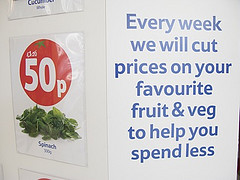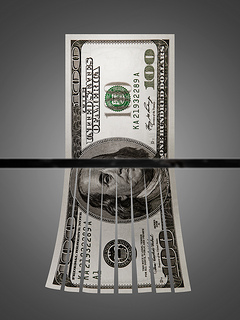 The consumer goods industry spends a fortune on in-store deals (and proportionally) more in online environments. By some calculations, the amount spent on promotions is significantly bigger than the total profit the company makes. That is a huge cost, and yet, when pressed, the reasons for the spend are a little opaque. Some proudly announce that their promotions are strategic, or are there to ‘reward the loyal shopper’. But when pushed, the real reasons for in-store deals become clear – it is hitting short term numbers, or keeping retailers quiet, or a bit of both. In this post I’d like to take a deeper look at this malaise, and question whether it is high time the practice changed.
The consumer goods industry spends a fortune on in-store deals (and proportionally) more in online environments. By some calculations, the amount spent on promotions is significantly bigger than the total profit the company makes. That is a huge cost, and yet, when pressed, the reasons for the spend are a little opaque. Some proudly announce that their promotions are strategic, or are there to ‘reward the loyal shopper’. But when pushed, the real reasons for in-store deals become clear – it is hitting short term numbers, or keeping retailers quiet, or a bit of both. In this post I’d like to take a deeper look at this malaise, and question whether it is high time the practice changed.
Why we run in-store deals
As marketers (be it trade marketers, consumer marketers or shopper marketers), we like to believe our activities are worthwhile and valuable. And given that many people in these roles spend most of their time managing promotions, we would like to believe that in-store deals add value. But the sad truth is that the vast majority of promotions do not. Our analysis suggests that a full 70% or more of promotions lose money (using the simplest evaluation of the promotion, and ignoring a lot of the hidden costs).
In-store deals rarely create long term changes in shopper or consumer behavior
Ah, yes, I hear you say, but MY promotions create strategic value. Hmmm. Well, that is a possibility, but it is unlikely. Most analyses of in-store deals suggest that much of the volume sold goes to people who would have bought the brand anyway, or would have bought it soon (and are therefore just bringing the purchase forward). Unless consumption of your category is highly elastic (take a bow, confectioners!) then all of these shoppers just got the volume they would have bought, at a discount. If you make (let’s say) a 40% margin, and you discounted the price by 20%: then you’ve just potentially lost half of your profit on all of those sales.
Another big chunk of promotion buyers are deal shoppers. They buy among a repertoire of brands, and buy whatever is on deal. For these shoppers, you’ve managed to get an extra sale (at reduced profit) but nothing more. Next week, or next month, or whenever they next enter the category, they will just buy whatever is on deal.
And yes, there may be some shoppers that we influence, and that could create long term change. We might create trial of our brand, that sets up a new, long term consumption. Yes – but not much and not often. In-store deals are sadly limited in their reach, and time and again analysis proves that they offer little commercial or strategic value.
In-store deals aren’t (always) a necessary part of working with a retailer
The other reason given for doing promotions is ‘because retailers demand them’. And yes, it is true that retailers demand in-store deals. Many brands would lose their listings if they didn’t promote. Some say that funding unprofitable promotions is ‘part of the way of doing business’. Well. Yes, and no. It’s hard to say no to powerful retailers, but many brands seem to manage to get away with few promotions. I used to work in the toy industry, which is highly prone to in-store deals. Yet Lego, arguably the most successful brand in the category of late, rarely if ever promotes. Gillette blades – the same story. I hunt for promotions and I use Gillette, yet I can rarely find them promoted in any of the countries I travel to.
Now maybe you’ve seen Gillette blades promoted. Maybe you’ve bought Lego on a deal – but around the world it is clear that it is possible for brands to exist without this obsessive promotion behavior. Let’s at least admit it is conceivable that it isn’t always necessary to promote brands, just because retailers ask for it.
Why we really run in-store deals
So, if they don’t really help the business grow in the long term, why do we promote so frequently? Why do we dedicate so much time to a loss-making activity? The simple answer is that sometimes we need to get short term volume. Our targets were set, and we have to try to hit them. Promotions are really useful at bringing in a lot of volume in a short amount of time – and unfortunately they are one of the few short term tools in our toolbox.
The irony of course is that it is the previous years’ promotions that are causing much of the problem. That big promotion we ran last October? It drove massive volume, but that then got reflected in this year’s numbers. Completely understandable (no-one wants to miss their targets, right?) but hardly a long term pattern we want to stick to.
How to tackle the scourge of in-store deals
Before I discuss what to do about this, perhaps let’s close off what NOT to do. DO NOT make a decision to stop doing in-store deals from tomorrow! That could be very painful. You may really upset your retail partners. Shoppers, trained to look for deals, might delay their purchases, rationalizing that the promotion is bound to come soon enough (because they always do!) Deal shoppers will just buy a different deal. The net result, unhappy retailers, and a drop in your sales. Not a good scenario, I’m sure you’ll agree.
So what to do?
Move slowly. Set sensible objectives to reduce the frequency or depth of deals over time (and I mean, over years). Remember this mess has taken decades to create – it isn’t going to be unpicked in a matter of months.
Start evaluating. Get a decent handle on what happens when brands are promoted. Find out who buys the promotions and who does not, and use this to identify which promotions are profitable, and which add some strategic value. Plan to do more of these, and less of the other.
Build a real agenda for growth. Work out what you will do with the money you save from promotions, and how that might drive your business forward. Focusing investment on growth is the only way to reduce the dependence on promotions. It’s also the only way to create an alternative value for retailers to buy into.
Build a new trade investment model. Retailers are hooked on your spend, that is true. So we need to get them off this poisonous habit. The best way is to make sure retailers still feel they are getting the same investment, albeit in a different way. Use shopper insight to demonstrate that you simply want to invest in them, but in a different way. No, I’m not saying that makes the conversation easy – but it does make change possible.
Get the business on board. Lastly, ensure that the business is on board with the approach. There will be bumps along the road, and that needs to be built into the plan. People need to understand the long journey that this inevitably is.
It isn’t easy, and it isn’t quick. But the challenge is clear. Promotional costs are going up. Retail demands are growing. We know that too many in-store deals is destructive, so now is the time to begin taking the first steps. For more on how discounts and deals are destroying brands, and what to do about it, download a copy of The Shopper Marketing Revolution here.


